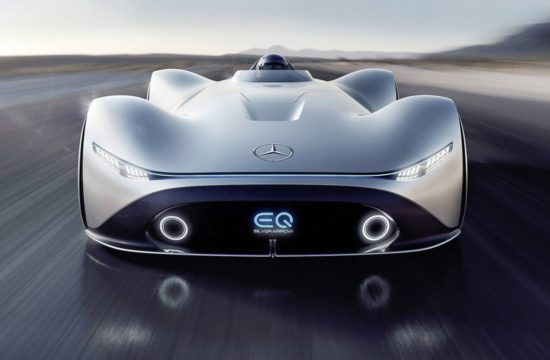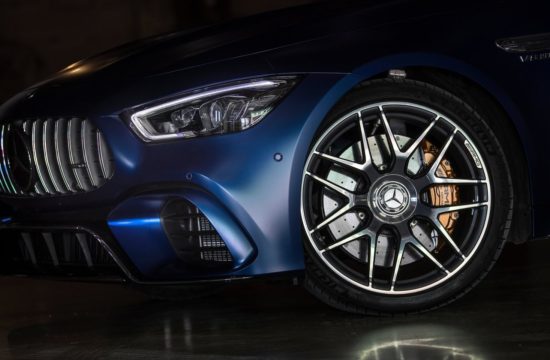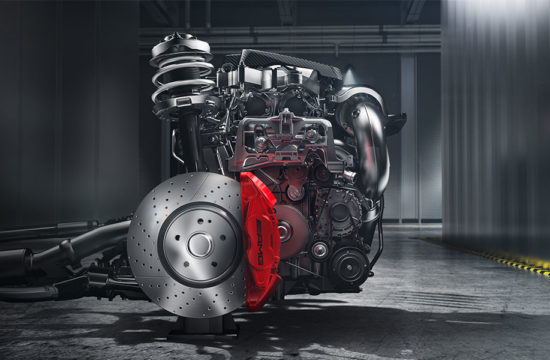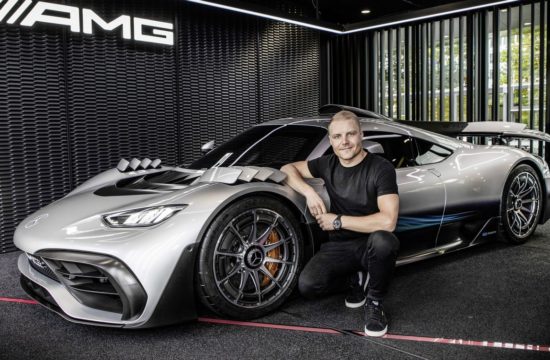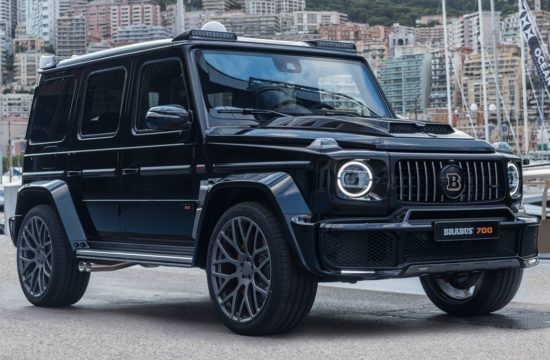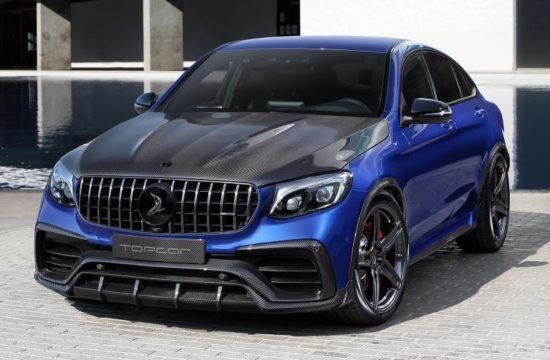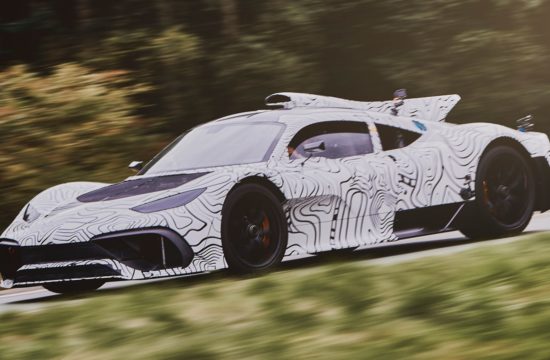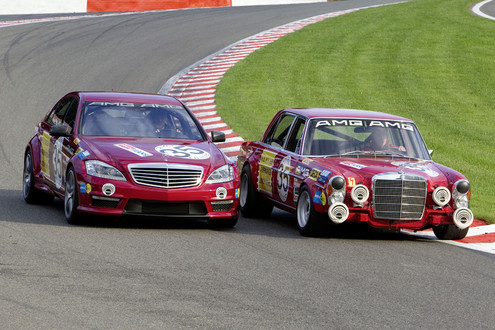
As we’ve already told you Mercedes Benz has made a special edition of the new S63 AMG, sporting the new 5.5 liter Bi-turbo V8 engine, as a sort of tribute to one of their magnificent racing cars. It’s the S63 AMG ”Thirty-Five” which is a reminder of an historic success on 25 July 1971, when the Mercedes 300 SEL 6.8 AMG finished second at 24-hour race in Spa-Francorchamps, making AMG a very famous company.
That car had the race number 35, like this new S-class. It has all the visual details of the original racing car like the bright red color or sponsor decals. The cabin of the car is also stripped-put to look like the racing version. They actually look like a father and son! Check out the pictures as the two meet on the legendary Spa circuit.
This S63 is also wider than normal models. But it’s just a show car and Mercedes won’t put it into production! You will get its brilliant new engine though. From 2011 all 63-AMG models will get this new and highly advanced 5.5 liter biturbo V8 which replaces the current normally aspirated 6.3 liter, and produces 544 hp in normal mode and 571 with the optional AMG performance pack.
Spectacular S 63 AMG”Thirty-Five” showcar in the style of the racing touring car
Like its historic predecessor, the new S 63 AMG showcar does not fail to attract attention. Eye-catching details include the imposing tyre sizes of 275/35 R 20 and 325/30 R 20 at the front/rear, and the 4.5 cm flare on each wing. The start number 35 and practically all the sponsoring stickers follow the original. Instead of fire-red non-metallic paintwork, the body of the showcar is finished in “AMG Le Mans red metallic”, a colour available exclusively for the new SLS AMG. The functional interior is enhanced with black/carbon-fibre piano lacquer trim. A rollover cage, two AMG sports bucket seats with four-point seat belts and an AMG sports steering wheel lined in leather/Alcantara underline the racing touring car look. This spectacular showcar provides an outlook on the series production version of the new S 63 AMG, which is due to be launched in September 2010.
More about this amazing engine, plus the story of SEL 6.8 AMG after the pictures…

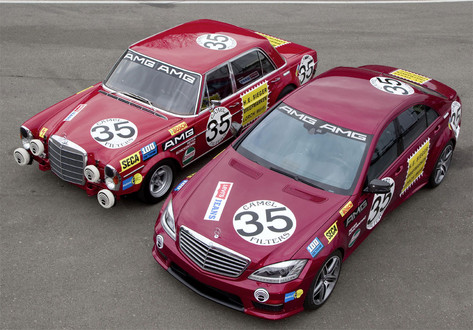
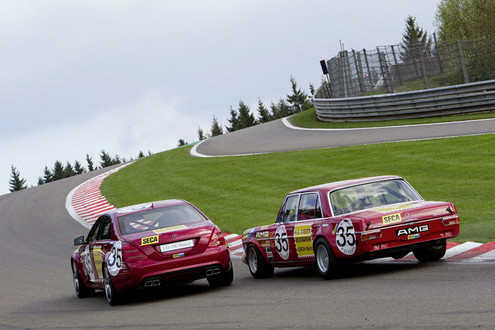
Mercedes 300 SEL 6.8 AMG Touring
The red four-door saloon already showed its potential in training, when Clemens Schickentanz surprised everyone with the fifth-fastest training time. Indeed nobody at AMG had expected fifth place in a starting line-up of 60 cars. 80,000 spectators wondered about the fast, red saloon with its long wheelbase – the only Mercedes taking part in the race. Pole position was occupied by the favourite, the Chevrolet Camaro driven by Ivo Grauls and Peter Hoffmann, followed by the Alpina-BMW 2800 CS of Niki Lauda/Gérard Larousse, then the first works Ford Capri with Dieter Glemser and Alex Soler-Roig, and the Schnitzer-BMW 2800 CS piloted by Rauno Aaltonen and Helmut Kelleners. All in all, 60 racing touring cars were seeking to beat the stopwatch on the then 14.1 kilometre course in the Ardennes, driven by well-known names such as Hans-Joachim-Stuck, Jochen Mass, Toine Hezemans, Willy Kauhsen, Achim Warmbold and Rainer Braun.
On the first lap, driver Hans Heyer in the 300 SEL 6.8 AMG was able to manoeuvre into 3rd place right behind the Ford Capri (Glemser/Soler-Roig) and the Chevrolet Camaro (Grauls/Hoffmann). After a turbulent race with a rainstorm at midnight and numerous breakdowns, the “35” finally crossed the finishing line in second place behind the works Capri driven by Glemser/Soler-Roig. The AMG saloon had absolved exactly 308 laps in the 24 hours. Technical problems: none at all. A sensational result.
Top speed of 265 km/h and exotic wood trim in the cockpit
Hans Heyer looks back fondly on this race: “We knew we could win, but the others did not know that yet!” The AMG saloon was unbeatable on the straight, however the braking system substantially adopted from the standard model had problems coping with the weight of the car (1635 kilograms). “But on the old Spa course the discs had plenty of time to cool down, and nobody was able to catch us on the long straights,” the now 67 year-old reminisces. With a top speed of 265 km/h, the 300 SEL 6.8 AMG was tailor-made for the fast Belgian track. The interior had a luxurious atmosphere with its standard appointments such as power steering, air suspension, carpets, panelled doors and a dashboard with exotic wood trim. The spectators along the trackside enthusiastically cheered the large saloon with its unmistakable V8 sound. “The outsider quickly became the public’s favourite,” says Hans Heyer.
The AMG racing saloon was technically based on the Mercedes-Benz 300 SEL 6.3. With an engine output of 184 kW (250 hp) at 4000 rpm and a top speed of 220 km/h, this luxury saloon was Germany’s fastest regular production car at the time. It was not only an enlarged displacement from 6330 to 6835 cc that increased the output to 315 kW (428 hp) at 5500 rpm, and torque from 500 to 608 newton metres. AMG co-founder Erhard Melcher “tweaked” the eight-cylinder power unit using classic methods: high-precision camshafts and modified rocker arms, lighter connecting rods, new Mahle pistons, larger intake valves, modified combustion chambers, polished intake and exhaust ducts, a new intake tract with two throttle flaps and a racing exhaust system ensured a better gas throughflow and made higher engine speeds possible. Endurance was improved by installing an additional oil cooler and finely balancing the crankshaft.
The wings were flared to make room for the lightweight size 10 x 15 and 12 x 15-inch magnesium wheels adopted from a C 111 test car. Aluminium doors helped to reduce the car’s weight from the original 1830 to 1635 kilograms. Larger front wishbones, a more robust rear axle with a heavy-duty differential and smaller, stiffer suspension air bellows made the saloon fit for the racetrack.
Sensational success reported on German TV news
The unexpected success in the 24-hour race at Spa-Francorchamps made AMG, which was founded in 1967, well-known overnight – and marked the start of an impressive success story. Even the German TV news “Tagesschau” reported on this sensational result. “It really was a sensation at the time,” AMG founder Hans Werner Aufrecht remembers. The courage shown by Aufrecht and his partner Melcher in entering such a car in the classic 24-hour race had been well rewarded.
Afterwards the 300 SEL 6.8 AMG took part in the 2×6 hour race at Paul Ricard on 11 and 12 September 1971, accompanied by a privately entered 300 SEL 6.3 with an AMG engine. In March 1972, now repainted in yellow, the 300 SEL 6.8 AMG took part in the trials for the Le Mans 24-hour race, but did not take to the starting line for the June race. The car was however entered in the 24-hour race at the Nürburgring in June 1972, and in the Nuremberg 200-mile race at the Norisring on 6 August 1972, where Hans Heyer took first place in the “Standard and special touring cars above 2000 cc” category with the four-door saloon, which had meanwhile been painted red again. The success story of the 300 SEL 6.8 AMG came to an end there: a rule-change by the Fédération Internationale de l’Automobile (FIA) put the brakes on this muscular racer, as only cars with an engine displacement of up to five litres were permitted to enter European Touring Car Championship races in future. AMG sold its racing saloon to the French Matra group, where it was converted for high-speed tests on aircraft tyres. Its subsequent fate is unknown. In spring 2006 Mercedes-AMG built a replica of the 300 SEL 6.8 AMG according to the original drawings, so as to keep this unique success story alive.
AMG’s new 5.5 Liter Bi-Turbo V8
With an overall displacement of 5461 cc, the new AMG 5.5-litre V8 biturbo unit makes do with exactly 747 cubic centimetres less compared to the naturally aspirated AMG 6.3-litre V8 with a displacement of 6208 cc. In addition to downsizing, AMG is also utilising the advantages of direct petrol injection with spray-guided combustion and piezo-electric injectors: thanks to its higher thermodynamic efficiency, this technology makes more efficient use of fuel and leads to lower exhaust emissions. AMG combines this spray-guided combustion with twin turbochargers. Other highlights include a crankcase wholly of aluminium, four-valve technology with adjustable camshafts, an air/water intercooler, generator management and a start/stop function as standard.
This high-tech package leads to a high output and torque yield, together with fuel consumption figures that are unrivalled in the competitive lineup. The AMG 5.5?litre V8 biturbo engine develops a peak output of 400 kW (544 hp) and maximum torque of 800 newton metres. In conjunction with the AMG Performance package these figures are increased to 420 kW
(571 hp) and 900 newton metres. The major difference between the two performance classes is an increase in the maximum charge pressure from 1.0 to 1.3 bar. A look at the performance diagrams shows that no other engine in this output class achieves the figures delivered by the new AMG biturbo.
Quantum leap: fuel consumption reduced by 25 percent
With a provisional NEDC fuel consumption of 10.5 litres per 100 kilometres, the new S 63 AMG is 3.9 litres more economical than the preceding model powered by the naturally aspirated AMG 6.3-litre V8 – despite an increase in output by 14 kW (19 hp) resp. 34 kW (46 hp) and in torque by 170 and 270 newton metres. Engine specialists consider this achieved fuel saving of more than 25 percent to be nothing less than a quantum leap. CO2 emissions have likewise been significantly reduced: at 246 grams per kilometre, the figure is 28.5 percent lower than for the previous model. Both performance variants have identical fuel consumption and CO2 figures.
With figures like these, the new S 63 AMG is not only considerably better than all its competitors, but also more fuel-efficient than much less powerful cars in this
segment. In some cases, in terms of its enormous output and torque figures, the new AMG 5.5-litre V8 biturbo engine is twice as efficient as many a medium or compact class diesel engine.
At the same time the S 63 AMG delivers superior performance at sports car level: the high-performance saloon accelerates from zero to 100 km/h in 4.5 seconds, and has an electronically limited top speed of 250 km/h. The 100 km/h mark is reached in just 4.4 seconds with the AMG Performance package, with the top speed increased to an electronically limited 300 km/h.
Engine production – tradition of hand-built excellence
Like all AMG engines, the new eight-cylinder biturbo is assembled by hand in the AMG engine shop taken into commission in 2002. A single, highly-qualified technician assembles the M 157 according to the “one man, one engine” philosophy, maintaining the very strictest quality standards – as attested by his signature on the characteristic AMG engine plate.
Key data at a glance*:
AMG 5.5-litre V8 biturbo engine
Displacement
5461 cc
Bore x stroke
98.0 x 90.5 mm
Compression ratio
10.0:1
Output
400 kW (544 hp) at 5500 rpm
420 kW (571 hp) at 5500 rpm**
Max. torque
800 Nm at 2000-4500 rpm
900 Nm at 2500-3750 rpm**
Engine weight (dry)
204 kg
Power/weight ratio
0.41 kg/hp
0.39 kg/hp**
* provisional figures; ** with AMG Performance package
Exciting power delivery, characteristic sound
These figures raise high expectations which the 400 kW (544 hp) AMG 5.5-litre V8 biturbo certainly meets. The flat torque curve ensures enormous pulling power in all speed ranges: 670 newton metres are already available at 1500 rpm, and the maximum torque of 800 newton metres is delivered just 500 rpm later, remaining constant to 4500 rpm. Even more effortless performance is ensured by the engine variant with the AMG Performance package, which has a peak output of 420 kW (571 hp). In this case the eight-cylinder delivers 875 newton metres of torque at just 2000 rpm, with a constant 900 newton metres available between 2500 and 3750 rpm.
It is not only the unrivalled torque delivery of this turbocharged eight-cylinder that makes the heart beat faster, as the agile responsiveness with no irritating charger delay leads to an effortlessness and dynamism previously unknown in this output class. All perfectly matched by the characteristic, sonorous engine note. Moreover, this AMG high-performance engine naturally meets all the requirements with respect to smooth, quiet running and the comfort on long journeys that is to be expected of a Mercedes.
MCT 7-speed sports transmission with Controlled Efficiency mode and start/stop function
Power is transferred by the AMG SPEEDSHIFT MCT 7-speed sports transmission used exclusively by AMG, which is already familiar from the SL 63 AMG and E 63 AMG and combines high emotional appeal with outstanding driving dyna-mics and a high level of efficiency. The wet start-up clutch replaces a conventional torque converter, and helps to save fuel. The exemplary fuel economy is also in large measure due to the standard start/stop function. This system is active in the transmission’s Controlled Efficiency (“C”) mode, and switches the eight-cylinder engine off when the car comes to a stop. In “C” mode the sports saloon always starts off in second gear, and the transmission shifts to the next, higher gears at a decidedly early stage. With its high torque at low engine speeds, the V8 engine encourages a smooth, effortless driving style.
The eight-cylinder biturbo engine also features the generator management system familiar from the E 63 AMG: whenever the engine is on the overrun or when braking, kinetic energy is used to charge the battery rather than being wasted as heat in the usual way. In all other operating modes a combination of onboard network and generator management enables the generator to be kept at a low voltage. This reduces the load on the engine and makes for fuel savings of around 0.15 litres per 100 kilometres according to the NEDC standard, and up to 0.2 l/ 100 km in city traffic with its frequent overrun and braking phases.
Long tradition of powerful AMG V8 engines
Powerful eight-cylinder engines are an inseparable part of AMG’s corporate history. One milestone in this history was the M 117, the first eight-cylinder with four-valve technology: with a displacement of 5.6 litres, 265 kW (360 hp) and 510 newton metres of torque, this V8 accelerated the Mercedes-Benz 300 CE 5.6 AMG to a top speed of 303 km/h in 1987. This made the coupé Germany’s fastest series-production car; American AMG fans reverently christened it “The Hammer”. Another important engine in the history of AMG was the supercharged AMG 5.5-litre V8 introduced in 2001: the M 113 K developed an output of up to 428 kW (582 hp) and torque of 800 newton metres. The supercharged AMG 5.5-litre V8 in the SLR McLaren of 2003 was even more powerful – it developed up to 478 kW (650 hp) and 820 newton metres. 2005 saw the debut of the AMG 6.3-litre V8 engine; depending on the model, the naturally aspirated, high-revving M 156 developed up to 386 kW (525 hp) and 630 newton metres. Exclusively reserved for the new SLS AMG, the likewise 6.3-litre M 159 has a maximum output of 420 kW (571 hp) and maximum torque of 650 newton metres.
The supercharged AMG 5.5-litre V8, the AMG 6.3-litre V8 and the AMG 6.0-litre V12 biturbo were all able to win the Best Performance Engine category in the International Engine of the Year Awards.

